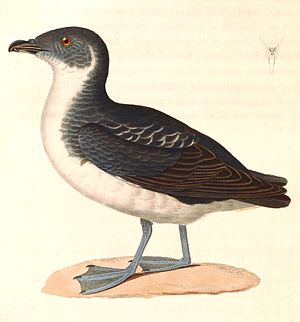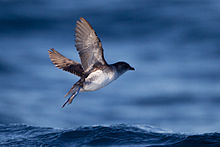Guillemot
This article has been registered in the quality assurance biology for improvement due to formal or content-related deficiencies . This is done in order to bring the quality of the biology articles to an acceptable level. Please help improve this article! Articles that are not significantly improved can be deleted if necessary.
Read the more detailed information in the minimum requirements for biology articles .
| Guillemot | ||||||||||
|---|---|---|---|---|---|---|---|---|---|---|

Guillemot |
||||||||||
| Systematics | ||||||||||
|
||||||||||
| Scientific name | ||||||||||
| Pelecanoides urinatrix | ||||||||||
| ( Gmelin , 1789) |
The guillotine petrel ( Pelecanoides urinatrix ), also known as the sub-Antarctic guillotine petrel or Berard petrel, is a small tubular nose from the genus of diving petrels ( Pelecanoides ).
features
The guillotine petrel reaches a body length of 20 to 25 cm, a weight of 86 to 185 g and a wingspan of 33 to 38 cm. The plumage is glossy black on the upper side and white on the underside. The sides of the head are blackish, tapering off to the sides of the neck and chest in dark gray. The color on the jugulum is often mottled gray and often forms a clear band. The sides and flanks are mottled light bluish gray and white. The shoulder feathers are dark gray, when not worn the tips are white and form a transverse stripe. The under wing coverts are white or light gray. The beak is black, the legs and feet bluish with black webbing . The iris is black.
The subspecies Pelecanoides urinatrix berard is similar to the nominate form , but the beak is usually smaller, the tail longer and the mottling on the throat more distinct. Pelecanoides urinatrix coppingeri is significantly smaller and has almost no gray mottling on the jugulum.
habitat
The range of this species is the Bass Strait between Australia and Tasmania and the surrounding waters of the Indian Ocean .
Way of life
The guillotine petrel lives sociable in large flocks, which fly together out to the open sea to hunt. There he gets his food from the water which he caught in a dive. Despite its short wings, which it mainly uses for launching from the surface of the water after a hunt, it is an excellent flyer. The bird feeds primarily on krill and other plankton organisms .
The breeding season varies depending on the distribution area. Guillotine petrels usually form colonies of up to 1500 individuals on the coast, but also inland . They breed in caves on ocean islands, which are dug on steep slopes but also on flat terrain.
Danger
The IUCN classifies the guillotine petrel as least concern , but the population is slowly declining.
Subspecies
Six subspecies of the guillemot have been described. The subspecies Pelecanoides urinatrix exsul and Pelecanoides urinatrix berard are sometimes considered to be separate species. Pelecanoides urinatrix elizabethae is proposed as a further subspecies, but is currently synonymous with Pelecanoides urinatrix dacunhae.
- Pelecanoides urinatrix dacunhae Nicoll , 1906 - Tristan da Cunha and Gough Island
- Pelecanoides urinatrix berard ( Gaimard , 1823) - Falkland Islands .
- Pelecanoides urinatrix. urinatrix ( Gmelin, JF , 1789) - Tasmania southeastern Australia , northern New Zealand .
- Pelecanoides urinatrix chathamensis Murphy & Harper , 1916 - Chathamine Islands , Snare Islands, and Stewart Island .
- Pelecanoides urinatrix exsul Salvin , 1896 - South Georgia and the South Sandwich Islands , east to Antipode Islands and Auckland Islands .
- Pelecanoides urinatrix coppingeri Mathews , 1912 - southern Chile .
Individual evidence
- ↑ a b c C. Carboneras, F. Jutglar, GM Kirwan (2017): Common Diving-petrel (Pelecanoides urinatrix). In: del Hoyo, J., Elliott, A., Sargatal, J., Christie, DA & de Juana, E. (eds.). Handbook of the Birds of the World Alive. Lynx Edicions, Barcelona. ( Online , accessed May 27, 2017).
- Jump up ↑ Berard Petrel, Guillemot, Sub-Antarctic Guillemot ( Pelecanoides urinatrix ) at Avibase
- ^ A b Emmet Reid Blake: Manual of Neotropical Birds, Volume 1. 1977, University of Chicago Press, ISBN 978-0226056418 , p. 134.
- ↑ Pelecanoides urinatrix in the IUCN 2017-1 Red List of Endangered Species . Listed by: BirdLife International, 2016. Retrieved May 27, 2017.
- ↑ Gill, F & D Donsker (Eds): IOC World Bird List , 2017, V 7.2, doi : 10.14344 / IOC.ML.7.2 . ( Online )
swell
- Christopher M. Perrins : The Great Encyclopedia of Birds. Orbis Verlag, 1996, ISBN 3-572-00810-7 , German. Translation from English, pp. 55–57.
- Goetz Rheinwald (ed.), Cyril Walker: Atlas of the bird world. Unipart, Remseck near Stuttgart 1994, ISBN 978-3-8122-3399-6 , p. 212.
- Fascinating bird life . German Translation (Birds of the World) 1992, Karl Müller Verlag, p. 18, ISBN 3-86070-320-X
Web links
- Pelecanoides urinatrix inthe IUCN 2017-1 Red List of Endangered Species . Listed by: BirdLife International, 2016. Retrieved May 27, 2017.
